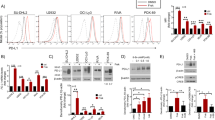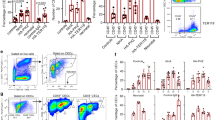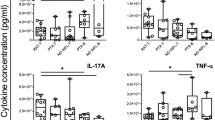Abstract
AGENTS which enhance intracellular adenosine 3′, 5′—monophosphate (cyclic AMP) levels by inhibiting cyclic AMP phosphodiesterase activity can increase the number of antibody forming cells (AFC) in humoral immunity both in vivo1,2 and in vitro3,4. Thus, cyclic AMP is a potential mediator of immune induction. But the same agents, at higher than optimal levels, can inhibit the AFC response1,3. Experiments have been done suggesting5 that enhanced intracellular cyclic AMP is a mediator of immune paralysis, or tolerance. The apparently contradictory conclusions drawn from these various experiments may be resolved if one considers a common kinetic feature of cyclic AMP responses to various agents, in lymphoid6–8 and in non-lymphoid9,10 cells; namely, that the rise in cyclic AMP level is transitory, and the cyclic nucleotide level returns to control values after a few minutes or hours. A similar transient rise in cyclic GMP lias been noted in phytohaemagglutinin-stimulated peripheral leukocytes, where this nucleotide seems to mediate the blastogenic response to the mitogen11. Thus, the same agents which might enhance an AFC response if present during the increased cyclic AMP phase, could inhibit the response if present during the subsequent phase of declining intracellular cyclic AMP. To see if this pattern was in fact part of an immune response in vitro, we performed experiments with sheep erythrocytes as immunising antigen, and varied the time of exposure of the immunocompetent cells to the agents N6, 2′-O-dibutyryl cyclic AMP or aminophylline. When present only during the first 12 or 24 h of exposure to antigen, these agents increased the number of AFC seen after 4 or 5 d of culture. But they inhibited the response if present during days 2 or 3. The effects of increasing intracellular cyclic AMP during the early period were twofold: (1) there was a delay in the arrival of cells at the antibody-secreting stage, and (2) the number of AFC at the optimal time was increased.
This is a preview of subscription content, access via your institution
Access options
Subscribe to this journal
Receive 51 print issues and online access
$199.00 per year
only $3.90 per issue
Buy this article
- Purchase on Springer Link
- Instant access to full article PDF
Prices may be subject to local taxes which are calculated during checkout
Similar content being viewed by others
References
Braun, W., and Ishizuka, M., J. Immun., 107, 1036–1042 (1971).
Uzunova, A. D., and Hanna, E. E., Cell. Immun., 7, 507–511 (1973).
Ishizuka, M., Braun, W., and Matsumoto, T., J. Immun., 107, 1027–1035 (1971).
Winchurch, R., and Actor, P., J. Immun., 108, 1305–1311 (1972).
Watson, J., Epstein, R., and Cohn, M., Nature, 246, 405–409 (1973).
Smith, J. W., Steiner, A. I., Newberry, W. M., jun., and Parker, C. W., J. clin. Invest., 50, 432–441 (1971).
Parker, C. W., Smith, J. W., and Steiner, A. L., Int. Arch. Allergy, 41, 40–46 (1971).
MacManus, J. P., Whitfleld, J. F., and Youdale, T., J. cell. comp. Physiol., 77, 103–116 (1971).
Exon, J. H., Lewis, S. B., Ho, R. J., Robison, G. A., and Park, C. R., Ann. N. Y. Acad. Sci., 185, 85–100 (1971).
MacManus, J. P., Franks, D. J., Youdale, T., and Braceland, B. M., Biochem. biophys. Res. Commun., 49, 1201–1207 (1972)
Hadden, J. W., Hadden, E. M., Haddox, M. K., and Goldberg, N. D., Proc. natn. Acad. Sci. U.S.A., 69, 3024–3027 (1972)
Lee, K.-C., Langman, R. E., Paetkau, V. H., and Diener, E., Eur. J. Immun., 3, 306–309 (1973).
Diener, E., and Armstrong, W. D., J. exp. Med., 129, 591–603 (1969).
Cunningham, A. J., and Szenberg, A., Immunology, 14, 599–600 (1968).
Heersche, J. N. M., Fedak, S. A., and Aurbach, G. D., J. biol. Chem., 246, 6770–6775 (1971).
Nakamura, I., Segal, S., Globerson, A., and Feldman, M., Cell Immun., 4, 351–366 (1972).
Millis, A. J. T., Forrest, G., and Pious, D. A., Biochem. biophys. Res. Commun., 49, 1645–1649 (1972).
McCrery, J. E., and Rigby, P. G., Proc. Soc. exp. Biol. Med., 140, 1456–1459 (1972).
Yamamoto, I., Shimamura, T., and Plescia, O. J., Fedn Proc., 33, 794 (1974).
Bösing-Schneider, R., and Kolb, H., Nature, 244, 224–225 (1973).
MacManus, J. P., Whitfield, J. F., and Braceland, B., Biochem. biophys. Res. Commun., 42, 503–509 (1971).
Author information
Authors and Affiliations
Rights and permissions
About this article
Cite this article
TEH, HS., PAETKAU, V. Biphasic effect of cyclic AMP on an immune response. Nature 250, 505–507 (1974). https://doi.org/10.1038/250505a0
Received:
Issue Date:
DOI: https://doi.org/10.1038/250505a0
This article is cited by
Comments
By submitting a comment you agree to abide by our Terms and Community Guidelines. If you find something abusive or that does not comply with our terms or guidelines please flag it as inappropriate.



